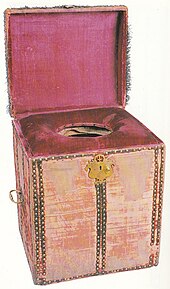

The Groom of the Stool (formally styled: "Groom of the King's Close Stool") was the most intimate of an English monarch's courtiers, initially responsible for assisting the king in excretion and hygiene.
The physical intimacy of the role naturally led to his becoming a man in whom much confidence was placed by his royal master and with whom many royal secrets were shared as a matter of course. This secret information—while it would never have been revealed, for it would have led to the discredit of his honour—in turn led to his becoming feared and respected and therefore powerful within the royal court in his own right. The office developed gradually over decades and centuries into one of administration of the royal finances, and under Henry VII, the Groom of the Stool became a powerful official involved in setting national fiscal policy, under the "chamber system".[1][2]
Later, the office was renamed Groom of the Stole. The Tudor historian David Starkey has attempted to frame this change as classic Victorianism: "When the Victorians came to look at this office, they spelt it s-t-o-l-e, and imagined all kinds of fictions about elaborate robes draped around the neck of the monarch at the coronation".[3] However, the change is in fact seen as early as the 17th century.[4]
- ^ For the role of the Groom of the Stool on the fiscal policy of Henry VII see: Starkey, D. The Virtuous Prince, 2009.
- ^ Re. the "Chamber System" and "Chamber Finance" see: Grummitt, D. "Henry VII, Chamber Finance and the 'New Monarchy': some New Evidence". Journal of the Institute of Historical Research, vol.72, no.179, pp.229-243. Published online 2003.
- ^ "Majesty in all its magnificence". The Daily Telegraph. Retrieved 19 October 2020.
- ^ "Page 1 | Issue 2054, 23 July 1685". The London Gazette. Retrieved 19 October 2020.